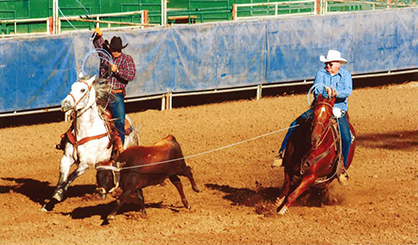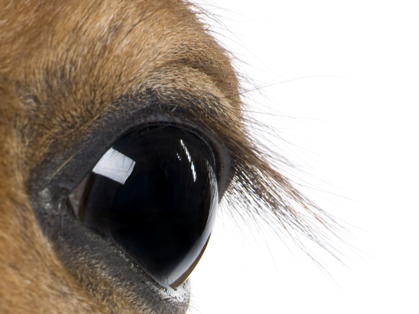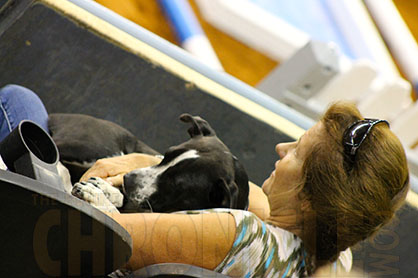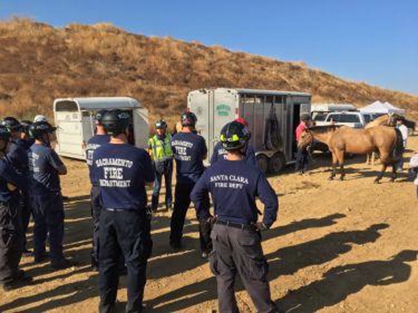UC Davis Helps Champion Quarter Horse Return to Competition After Botulism Poisoning
November 2, 2017 Comments Off on UC Davis Helps Champion Quarter Horse Return to Competition After Botulism Poisoning
John remained hospitalized at UC Davis for 26 days. During that time, he was treated with botulism anti-toxin plasma. He received other supportive care including intravenous fluid therapy, anti-inflammatories, and vitamin E. John was unable to stand without help, so faculty, staff and students in the Large Animal Clinic instituted the “Large Animal Lift” to assist him to stand.
Continue reading …National Equine Health Plan Published
November 1, 2017 Comments Off on National Equine Health Plan Published
“We have seen firsthand how disease outbreaks cost the industry millions of dollars for the care of sick horses, implementation of biosecurity, and lost revenue in the form of cancelled or restricted commercial equine activities such as horseshows,” said AHC President Julie Broadway.
Continue reading …What Are the Costs of Horse Ownership?
October 14, 2017 Comments Off on What Are the Costs of Horse Ownership?
Did You Know? The top-priced Thoroughbred yearling at the 2015 Keeneland September Sale sold for $2.1M. Even though you are probably not planning to buy the next Triple Crown winner, it is important to consider all costs of horse ownership before deciding to purchase one.
Continue reading …Have You Ever Considered Your Pet’s Mental Health?
October 13, 2017 Comments Off on Have You Ever Considered Your Pet’s Mental Health?
In dogs, mental illness commonly manifests in the form of:
– aggression towards people or animals
– fears and phobias, for example of thunderstorms
– compulsion such as tail or shadow chasing
– cognitive decline in older dogs.
New Research Suggests Pets Can Help Those Living with Mental Illness
October 12, 2017 Comments Off on New Research Suggests Pets Can Help Those Living with Mental Illness
The study involved 54 participants with a severe mental illness, for example, schizophrenia or bipolar disorder. Twenty-five of the participants identified a pet as being important in the everyday management of their illness. What’s more, of these 25 participants, more than half identified their pet as being one of the most important things to them in managing their mental health.
Continue reading …Diagnosis Congress Crud – Tips to Stay Healthy During the Congress
October 12, 2017 Comments Off on Diagnosis Congress Crud – Tips to Stay Healthy During the Congress
Some claim that you can only fight it off with Emergen-C® and vodka. Some people swear that you can catch it simply by watching the live feed. Others maintain that if you sleep in your tack stall, just once, you’re doomed.
Continue reading …Snakes are Springing – Protect Your Animals from Deadly Encounters
October 11, 2017 Comments Off on Snakes are Springing – Protect Your Animals from Deadly Encounters
Bites from some snakes will cause an animal to collapse, and then seem to recover. This can give false confidence that the animal is okay, but what is really happening is the snake toxins are spreading through the system and wreaking havoc. Within a few hours, other signs start to develop.
Continue reading …A Trail Riding Accident, a Horse With a Fractured Leg, Would You Know What to Do?
October 10, 2017 Comments Off on A Trail Riding Accident, a Horse With a Fractured Leg, Would You Know What to Do?
The scenario Green organized revolved around a trail riding accident involving a fallen horse that suffered a repairable fractured leg. The horse owner and riding companions remained at risk from the injured animal (represented by a life-sized mannequin), and the presence of live animals and riders from the Alameda County Sheriff’s Mounted Posse enhanced the reality of the exercise.
Continue reading …Fruits are Fabulous, Even for Insulin Resistant Horses!
October 6, 2017 Comments Off on Fruits are Fabulous, Even for Insulin Resistant Horses!
Dark blue and red berries, such as blueberries, blackberries, raspberries, and strawberries as well as cherries and red grapes, contain antioxidants known as epicatechins and anthocyanidins that belong to a group of antioxidants known as flavonoids.
Continue reading …Controlling Parasites in Horses Without Contributing to Resistance
October 4, 2017 Comments Off on Controlling Parasites in Horses Without Contributing to Resistance
In rainy, temperate areas, horses may experience a higher incidence for parasites, as such conditions are an ideal environmental support of the parasite, lending itself to more parasite life cycles per season.
Continue reading …







